How to use DateTime in Python
All data is automatically assigned a "DOB" (Date of Birth) at the beginning. Therefore, it is inevitable to encounter date and time data when processing data at some point. This tutorial will take you through the datetime module in Python and using some peripheral libraries such as pandas and pytz.
In Python, anything related to date and time is handled by the datetime module, which further divides the module into 5 different classes. Classes are simply data types that correspond to objects. The figure below summarizes the 5 datetime classes in Python along with commonly used properties and examples.
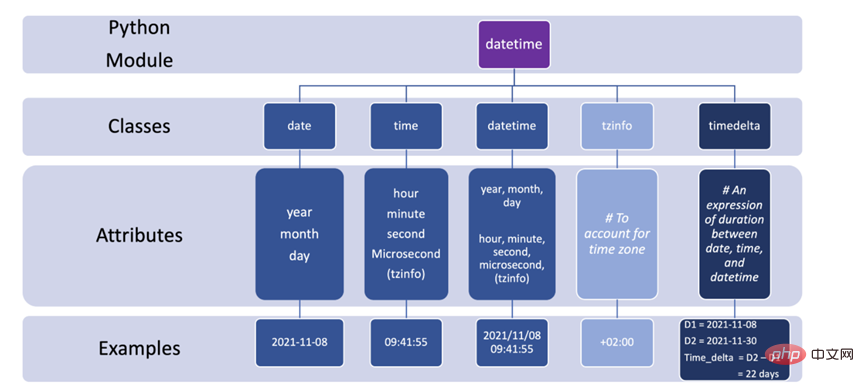
#3 useful snippets
1. Convert a string to datetime format, perhaps the most common case of using datetime.
Due to the alphanumeric nature of dates and times, parsing similar dates and times into Python will often be interpreted as strings. In this section, we'll cover how to parse a list of strings into datetime format, and how to split and combine date and time data into individual columns in a data frame.
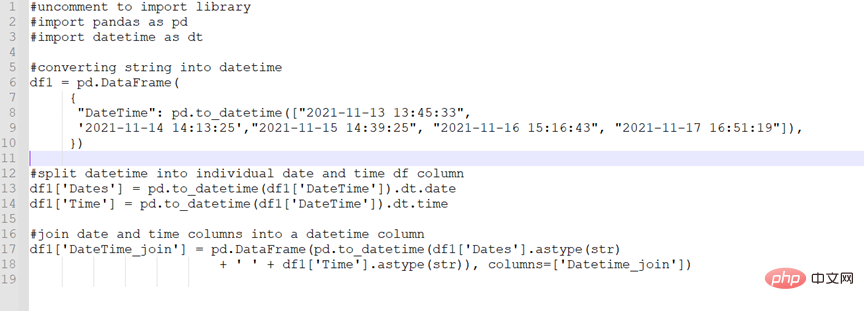

Printout of Fragment 1
However, if the date-time behaves in an unusual or ambiguous way What about formatting? A common question is the difference between the way dates and times are written in the United States and Europe. In American format, the month comes first, while in European style, the day comes first.
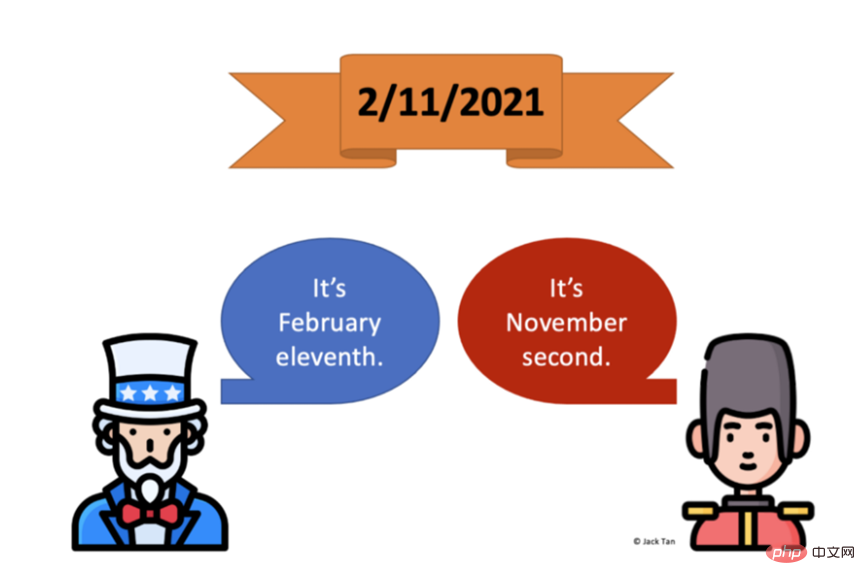
By default, to_datetime in pandas converts an object to a datetime by parsing the previous number with less than 12 digits (
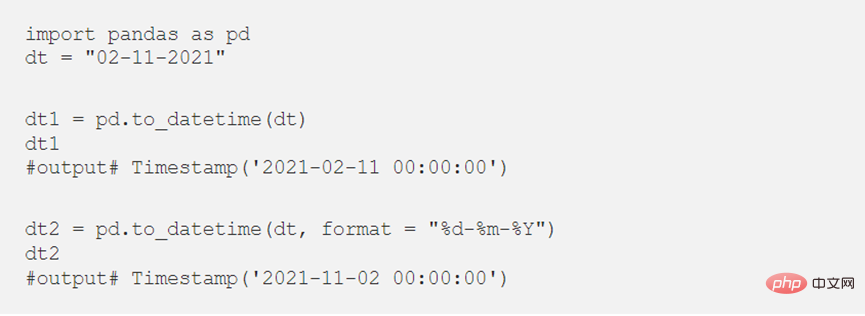
#Alternatively, the strftime() method helps to format the datetime before returning the string. In the following example, the dashes (-) between the original date times are replaced with backslashes (/), and the numeric month (02) is replaced with the abbreviated English term (Feb).

Since there are many ways to interpret dates (day, month, year) and times (hours, minutes, seconds), understand the different format codes to It's important. The table below is a cheat sheet for commonly used format codes.
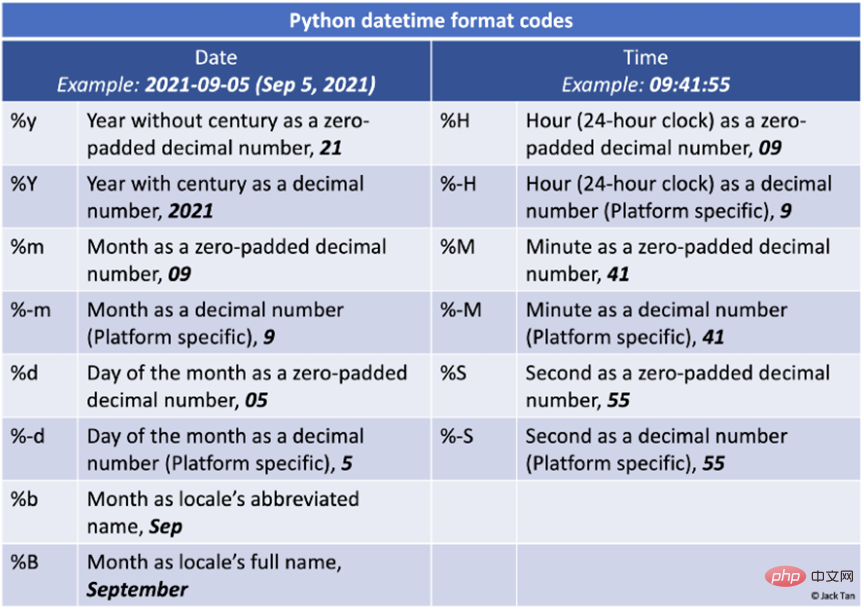
2. Use time zone
A datetime object without time zone information is called "naive", an object with time zone information (usually with HH at the end :MM corresponding to GMT) is considered "aware". Probably one of the most comprehensive libraries in Python, pytz simplifies the task of time zone calculations. The following code snippet will show you how to convert between "naive" and "aware" datetime objects, and can use different time zones. The last part of the code also demonstrates how to convert the given datetime object to the local time zone. This example shows time zone codes for Japan and Germany, for other regions you can refer here.
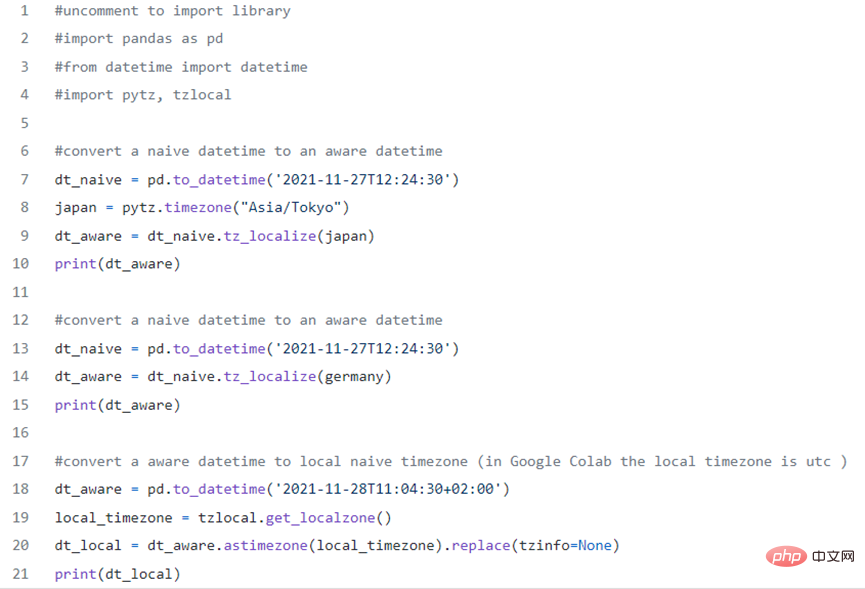

Output of Fragment 2
3. Use interval to compare two datetime(s)
Sometimes we have to compare two datetimes conditionally. Imagine that you have two dataframes, the first contains only one column of datetime and the second contains two columns representing intervals and other information in the remaining columns. Your goal is to find a matching datetime from the first dataframe if it falls within the interval of the second dataframe, and if so, copy the other columns.

One way to achieve this is to use pd.Interval to compress the interval between two datetimes and then assign them as indices of a dataframe that can later be used with Conditionally compare and map datetimes. This can be done by using a for loop to copy the columns of interest if the time condition is met.

Original text: https://towardsdatascience.com/how-to-work-with-datetime-in-python-26d4092dc484
The above is the detailed content of How to use DateTime in Python. For more information, please follow other related articles on the PHP Chinese website!

Hot AI Tools

Undresser.AI Undress
AI-powered app for creating realistic nude photos

AI Clothes Remover
Online AI tool for removing clothes from photos.

Undress AI Tool
Undress images for free

Clothoff.io
AI clothes remover

Video Face Swap
Swap faces in any video effortlessly with our completely free AI face swap tool!

Hot Article

Hot Tools

Notepad++7.3.1
Easy-to-use and free code editor

SublimeText3 Chinese version
Chinese version, very easy to use

Zend Studio 13.0.1
Powerful PHP integrated development environment

Dreamweaver CS6
Visual web development tools

SublimeText3 Mac version
God-level code editing software (SublimeText3)

Hot Topics
 1664
1664
 14
14
 1421
1421
 52
52
 1315
1315
 25
25
 1266
1266
 29
29
 1239
1239
 24
24
 PHP and Python: Different Paradigms Explained
Apr 18, 2025 am 12:26 AM
PHP and Python: Different Paradigms Explained
Apr 18, 2025 am 12:26 AM
PHP is mainly procedural programming, but also supports object-oriented programming (OOP); Python supports a variety of paradigms, including OOP, functional and procedural programming. PHP is suitable for web development, and Python is suitable for a variety of applications such as data analysis and machine learning.
 Choosing Between PHP and Python: A Guide
Apr 18, 2025 am 12:24 AM
Choosing Between PHP and Python: A Guide
Apr 18, 2025 am 12:24 AM
PHP is suitable for web development and rapid prototyping, and Python is suitable for data science and machine learning. 1.PHP is used for dynamic web development, with simple syntax and suitable for rapid development. 2. Python has concise syntax, is suitable for multiple fields, and has a strong library ecosystem.
 PHP and Python: A Deep Dive into Their History
Apr 18, 2025 am 12:25 AM
PHP and Python: A Deep Dive into Their History
Apr 18, 2025 am 12:25 AM
PHP originated in 1994 and was developed by RasmusLerdorf. It was originally used to track website visitors and gradually evolved into a server-side scripting language and was widely used in web development. Python was developed by Guidovan Rossum in the late 1980s and was first released in 1991. It emphasizes code readability and simplicity, and is suitable for scientific computing, data analysis and other fields.
 Python vs. JavaScript: The Learning Curve and Ease of Use
Apr 16, 2025 am 12:12 AM
Python vs. JavaScript: The Learning Curve and Ease of Use
Apr 16, 2025 am 12:12 AM
Python is more suitable for beginners, with a smooth learning curve and concise syntax; JavaScript is suitable for front-end development, with a steep learning curve and flexible syntax. 1. Python syntax is intuitive and suitable for data science and back-end development. 2. JavaScript is flexible and widely used in front-end and server-side programming.
 How to run sublime code python
Apr 16, 2025 am 08:48 AM
How to run sublime code python
Apr 16, 2025 am 08:48 AM
To run Python code in Sublime Text, you need to install the Python plug-in first, then create a .py file and write the code, and finally press Ctrl B to run the code, and the output will be displayed in the console.
 Where to write code in vscode
Apr 15, 2025 pm 09:54 PM
Where to write code in vscode
Apr 15, 2025 pm 09:54 PM
Writing code in Visual Studio Code (VSCode) is simple and easy to use. Just install VSCode, create a project, select a language, create a file, write code, save and run it. The advantages of VSCode include cross-platform, free and open source, powerful features, rich extensions, and lightweight and fast.
 Golang vs. Python: Performance and Scalability
Apr 19, 2025 am 12:18 AM
Golang vs. Python: Performance and Scalability
Apr 19, 2025 am 12:18 AM
Golang is better than Python in terms of performance and scalability. 1) Golang's compilation-type characteristics and efficient concurrency model make it perform well in high concurrency scenarios. 2) Python, as an interpreted language, executes slowly, but can optimize performance through tools such as Cython.
 How to run python with notepad
Apr 16, 2025 pm 07:33 PM
How to run python with notepad
Apr 16, 2025 pm 07:33 PM
Running Python code in Notepad requires the Python executable and NppExec plug-in to be installed. After installing Python and adding PATH to it, configure the command "python" and the parameter "{CURRENT_DIRECTORY}{FILE_NAME}" in the NppExec plug-in to run Python code in Notepad through the shortcut key "F6".




